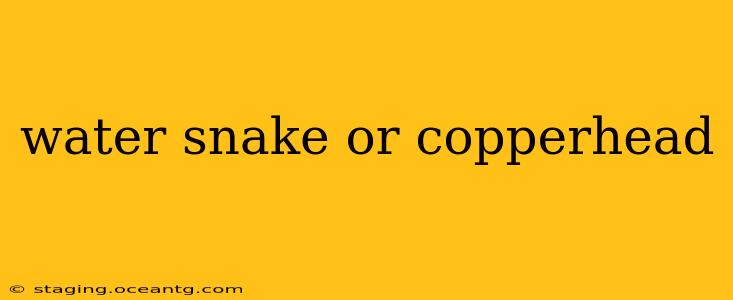Identifying venomous snakes is crucial for safety, especially when enjoying outdoor activities. The water snake and copperhead are often confused, leading to unnecessary fear or risky encounters. This guide will help you distinguish these two snakes, focusing on key physical characteristics and habitat preferences. Knowing the differences can prevent accidental harm and promote responsible coexistence with wildlife.
What are the key physical differences between a water snake and a copperhead?
This is the most frequently asked question when comparing these two snakes. The key lies in careful observation of several features:
-
Head Shape: Copperheads have a distinctive triangular-shaped head, wider than their neck, which is a characteristic of many pit vipers (venomous snakes). Water snakes generally have a more oval or elongated head, less distinctly separated from their neck.
-
Color and Pattern: Copperheads exhibit a characteristic reddish-brown, copper-colored body with hourglass-shaped crossbands. These bands are typically dark brown or reddish-brown, often with a darker, almost black, outline. Water snakes display a much wider variety of colors and patterns. They can be brown, black, gray, or olive green, often with darker blotches or stripes running along their bodies. There's no consistent hourglass pattern.
-
Eye Color: While not always definitive, copperheads often have reddish or copper-colored eyes, while water snakes tend to have more yellow, brown, or black eyes.
-
Pupil Shape: Copperheads, like other pit vipers, have elliptical pupils. Water snakes, being non-venomous, possess round pupils. However, observing pupil shape may be difficult and requires a safe distance.
-
Heat-Sensing Pits: Copperheads, being pit vipers, possess heat-sensing pits between their eyes and nostrils, which helps them locate warm-blooded prey. Water snakes lack these pits. This is a crucial distinguishing factor but requires very close examination.
How can I tell the difference from a distance?
Distinguishing between a water snake and a copperhead from a safe distance can be challenging, but focusing on the head shape and overall pattern can help. The triangular head of a copperhead is more easily visible even at a distance, along with the consistent hourglass banding. If you are unsure, it's always best to err on the side of caution and maintain a safe distance. Never attempt to handle a snake you can't positively identify.
What is the habitat of each snake?
Understanding their habitats can help in identification.
-
Copperheads: Prefer rocky, wooded areas, often near streams or other water sources. They are ambush predators and tend to remain hidden amongst leaf litter or rocks.
-
Water Snakes: As their name suggests, water snakes are found near bodies of water such as ponds, lakes, rivers, and marshes. They are often seen swimming or basking on rocks or logs near the water.
Are water snakes venomous?
No, water snakes are not venomous. They are constrictors, meaning they kill their prey by squeezing it. While they may bite defensively if threatened, their bite is not medically significant.
Are copperheads aggressive?
Copperheads are generally not aggressive snakes, preferring to avoid confrontation. However, like all venomous snakes, they will bite if they feel threatened or cornered. A defensive bite is more likely to occur if a person accidentally steps on or tries to handle the snake.
What should I do if I encounter a snake?
- Maintain a safe distance: Observe the snake from a safe distance without approaching it.
- Identify the snake (carefully): If possible, try to identify the snake using the characteristics described above. Remember, identification from a distance can be challenging.
- Leave the snake alone: Avoid any attempts to handle or capture the snake.
- Seek professional help (if needed): If you believe you have been bitten by a venomous snake, seek immediate medical attention.
By carefully observing these key differences, you can learn to differentiate between a water snake and a copperhead, fostering a greater understanding and appreciation of the natural world while staying safe. Remember, accurate identification requires patience and careful observation. If you're unsure, it's always best to leave the snake undisturbed.
